Comparison of Typical Alpine Lake Surface Elevation Variations and Different Driving Forces by Remote Sensing Altimetry Method
Abstract
1. Introduction
2. Materials and Methods
2.1. Study Area
2.2. Data
2.2.1. Lake Surface Elevation Data
2.2.2. Meteorological Data
2.3. Methodology
2.3.1. Surface Elevation Extraction of Lakes
2.3.2. Basin Climate Variable Extraction
3. Results
3.1. Verification of Elevation Extraction Accuracy
3.2. Surface Elevation Extraction of Central Asian High Mountain Lakes
4. Discussion
4.1. Analysis of the Main Drivers of Lake Karakul
4.2. Analysis of the Main Drivers of Lake Chatyrkul
4.3. Analysis of Differences in Lake Variation Patterns
5. Conclusions
Author Contributions
Funding
Institutional Review Board Statement
Informed Consent Statement
Data Availability Statement
Acknowledgments
Conflicts of Interest
References
- Che, X.H.; Feng, M.; Sun, Q.; Sexton, J.O.; Channan, S.; Liu, J.P. The Decrease in Lake Numbers and Areas in Central Asia Investigated Using a Landsat-Derived Water Dataset. Remote Sens. 2021, 13, 1032. [Google Scholar] [CrossRef]
- Feng, M.; Sexton, J.O.; Channan, S.; Townshend, J.R. A global, high-resolution (30-m) inland water body dataset for 2000: First results of a topographic-spectral classification algorithm. Int. J. Digit. Earth 2016, 9, 113–133. [Google Scholar] [CrossRef]
- Palmer, S.C.J.; Kutser, T.; Hunter, P.D. Remote sensing of inland waters: Challenges, progress and future directions. Remote Sens. Environ. 2015, 157, 1–8. [Google Scholar] [CrossRef]
- An, C.J.; Zhang, F.; Chan, N.W.; Johnson, V.C.; Shi, J.C. A review on the research progress of lake water volume estimation methods. J. Environ. Manag. 2022, 314, 12. [Google Scholar] [CrossRef] [PubMed]
- Zhang, Y.J.; Wang, N.L.; Yang, X.W.; Mao, Z.L. The Dynamic Changes of Lake Issyk-Kul from 1958 to 2020 Based on Multi-Source Satellite Data. Remote Sens. 2022, 14, 1575. [Google Scholar] [CrossRef]
- Wu, Y.H.; Li, M.R.; Guo, L.N.; Zheng, H.X.; Zhang, H.Y. Investigating Water Variation of Lakes in Tibetan Plateau Using Remote Sensed Data Over the Past 20 Years. IEEE J. Sel. Top. Appl. Earth Observ. Remote Sens. 2019, 12, 2557–2564. [Google Scholar] [CrossRef]
- Meng, K.; Shi, X.H.; Wang, E.; Liu, F. High-altitude salt lake elevation changes and glacial ablation in Central Tibet, 2000-2010. Chin. Sci. Bull. 2012, 57, 525–534. [Google Scholar] [CrossRef]
- Xu, Y.Y.; Lin, J.; Zhao, J.W.; Zhu, X.Y. New method improves extraction accuracy of lake water bodies in Central Asia. J. Hydrol. 2021, 603, 12. [Google Scholar] [CrossRef]
- Wu, Y.H.; Zhang, X.; Zheng, H.X.; Li, J.S.; Wang, Z.Y. Investigating changes in lake systems in the south-central Tibetan Plateau with multi-source remote sensing. J. Geogr. Sci. 2017, 27, 337–347. [Google Scholar] [CrossRef]
- Song, C.Q.; Huang, B.; Ke, L.H. Heterogeneous change patterns of water level for inland lakes in High Mountain Asia derived from multi-mission satellite altimetry. Hydrol. Processes 2015, 29, 2769–2781. [Google Scholar] [CrossRef]
- Schwatke, C.; Dettmering, D.; Bosch, W.; Seitz, F. DAHITI—An innovative approach for estimating water level time series over inland waters using multi-mission satellite altimetry. Hydrol. Earth Syst. Sci. 2015, 19, 4345–4364. [Google Scholar] [CrossRef]
- He, J.; Hayashi, M. Lake O’Hara alpine hydrological observatory: Hydrological and meteorological dataset, 2004–2017. Earth Syst. Sci. Data 2019, 11, 111–117. [Google Scholar] [CrossRef]
- Bonacci, O.; Andric, I.; Yamashiki, Y. Hydrology of Blue Lake in the Dinaric karst. Hydrol. Processes 2014, 28, 1890–1898. [Google Scholar] [CrossRef]
- Xie, J.F.; Li, B.B.; Jiao, H.H.; Zhou, Q.Q.; Mei, Y.K.; Xie, D.H.; Wu, Y.; Sun, X.Y.; Fu, Y. Water Level Change Monitoring Based on a New Denoising Algorithm Using Data from Landsat and ICESat-2: A Case Study of Miyun Reservoir in Beijing. Remote Sens. 2022, 14, 4344. [Google Scholar] [CrossRef]
- Cretaux, J.F.; Jelinski, W.; Calmant, S.; Kouraev, A.; Vuglinski, V.; Berge-Nguyen, M.; Gennero, M.C.; Nino, F.; Del Rio, R.A.; Cazenave, A.; et al. SOLS: A lake database to monitor in the Near Real Time water level and storage variations from remote sensing data. Adv. Space Res. 2011, 47, 1497–1507. [Google Scholar] [CrossRef]
- Kim, I.W.; Oh, J.; Woo, S.; Kripalani, R.H. Evaluation of precipitation extremes over the Asian domain: Observation and modelling studies. Clim. Dyn. 2019, 52, 1317–1342. [Google Scholar] [CrossRef]
- Naz, B.S.; Kollet, S.; Franssen, H.-J.H.; Montzka, C.; Kurtz, W. A 3 km spatially and temporally consistent European daily soil moisture reanalysis from 2000 to 2015. Sci. Data 2020, 7, 111. [Google Scholar] [CrossRef]
- Jena, B.; Kumar, A.; Ravichandran, M.; Kern, S. Mechanism of sea-ice expansion in the Indian Ocean sector of Antarctica: Insights from satellite observation and model reanalysis. PLoS ONE 2018, 13, e0203222. [Google Scholar] [CrossRef]
- Huang, X.L.; Soden, B.J.; Jackson, D.L. Interannual co-variability of tropical temperature and humidity: A comparison of model, reanalysis data and satellite observation. Geophys. Res. Lett. 2005, 32, 5. [Google Scholar] [CrossRef]
- Ning, S.W.; Song, F.; Udmale, P.; Jin, J.L.; Thapa, B.R.; Ishidaira, H. Error Analysis and Evaluation of the Latest GSMap and IMERG Precipitation Products over Eastern China. Adv. Meteorol. 2017, 2017, 16. [Google Scholar] [CrossRef]
- Wang, B.B.; Ma, Y.M.; Su, Z.B.; Wang, Y.; Ma, W.Q. Quantifying the evaporation amounts of 75 high-elevation large dimictic lakes on the Tibetan Plateau. Sci. Adv. 2020, 6, 10. [Google Scholar] [CrossRef] [PubMed]
- Xu, F.L.; Zhang, G.Q.; Yi, S.; Chen, W.F. Seasonal trends and cycles of lake-level variations over the Tibetan Plateau using multi-sensor altimetry data. J. Hydrol. 2022, 604, 14. [Google Scholar] [CrossRef]
- Mischke, S.; Lai, Z.P.; Aichner, B.; Heinecke, L.; Mahmoudov, Z.; Kuessner, M.; Herzschuh, U. Radiocarbon and optically stimulated luminescence dating of sediments from Lake Karakul, Tajikistan. Quat. Geochronol. 2017, 41, 51–61. [Google Scholar] [CrossRef]
- Heinecke, L.; Fletcher, W.J.; Mischke, S.; Tian, F.; Herzschuh, U. Vegetation change in the eastern Pamir Mountains, Tajikistan, inferred from Lake Karakul pollen spectra of the last 28 kyr. Palaeogeogr. Palaeoclimatol. Palaeoecol. 2018, 511, 232–242. [Google Scholar] [CrossRef]
- Yan, D.N.; Xu, H.; Lan, J.H.; Zhou, K.G.; Ye, Y.D.; Zhang, J.X.; An, Z.S.; Yeager, K.M. Solar activity and the westerlies dominate decadal hydroclimatic changes over arid Central Asia. Glob. Planet. Change 2019, 173, 53–60. [Google Scholar] [CrossRef]
- Dai, X.A.; Yang, X.P.; Wang, M.L.; Gao, Y.; Liu, S.H.; Zhang, J.M. The Dynamic Change of Bosten Lake Area in Response to Climate in the Past 30 Years. Water 2020, 12, 4. [Google Scholar] [CrossRef]
- Tang, X.M.; Xie, G.J.; Deng, J.M.; Shao, K.Q.; Hu, Y.; He, J.; Zhang, J.P.; Gao, G. Effects of climate change and anthropogenic activities on lake environmental dynamics: A case study in Lake Bosten Catchment, NW China. J. Environ. Manag. 2022, 319, 10. [Google Scholar] [CrossRef]
- Deng, X.; Wang, R.B.; Peng, F.; Yang, Y.; Mo, N.M. Retracking Cryosat-2 Data in SARIn and LRM Modes for Plateau Lakes: A Case Study for Tibetan and Dianchi Lakes. Remote Sens. 2021, 13, 1078. [Google Scholar] [CrossRef]
- Alifujiang, Y.; Abuduwaili, J.; Groll, M.; Issanova, G.; Maihemuti, B. Changes in intra-annual runoff and its response to climate variability and anthropogenic activity in the Lake Issyk-Kul Basin, Kyrgyzstan. Catena 2021, 198, 18. [Google Scholar] [CrossRef]
- Leroy, S.A.G.; Ricketts, R.D.; Rasmussen, K.A. Climatic and limnological changes 12,750 to 3600 years ago in the Issyk-Kul catchment, Tien Shan, based on palynology and stable isotopes. Quat. Sci. Rev. 2021, 259, 18. [Google Scholar] [CrossRef]
- Jiang, L.G.; Schneider, R.; Andersen, O.B.; Bauer-Gottwein, P. CryoSat-2 Altimetry Applications over Rivers and Lakes. Water 2017, 10, 20. [Google Scholar] [CrossRef]
- Villadsen, H.; Andersen, O.B.; Stenseng, L.; Nielsen, K.; Knudsen, P. CryoSat-2 altimetry for river level monitoring—Evaluation in the Ganges-Brahmaputra River basin. Remote Sens. Environ. 2015, 168, 80–89. [Google Scholar] [CrossRef]
- Kleinherenbrink, M.; Ditmar, P.G.; Lindenbergh, R.C. Retracking Cryosat data in the SARIn mode and robust lake level extraction. Remote Sens. Environ. 2014, 152, 38–50. [Google Scholar] [CrossRef]
- Meloni, M.; Bouffard, J.; Parrinello, T.; Dawson, G.; Garnier, F.; Helm, V.; Di Bella, A.; Hendricks, S.; Ricker, R.; Webb, E.; et al. CryoSat Ice Baseline-D validation and evolutions. Cryosphere 2020, 14, 1889–1907. [Google Scholar] [CrossRef]
- Tarek, M.; Brissette, F.P.; Arsenault, R. Evaluation of the ERA5 reanalysis as a potential reference dataset for hydrological modelling over North America. Hydrol. Earth Syst. Sci. 2020, 24, 2527–2544. [Google Scholar] [CrossRef]
- Hersbach, H.; Bell, B.; Berrisford, P.; Hirahara, S.; Horányi, A.; Muñoz-Sabater, J.; Simmons, A. The ERA5 global reanalysis. Q. J. R. Meteorol. Soc. 2020, 146, 1999–2049. [Google Scholar] [CrossRef]
- Jiang, Q.; Li, W.; Fan, Z.; He, X.; Sun, W.; Chen, S.; Wen, J.; Gao, J.; Wang, J. Evaluation of the ERA5 reanalysis precipitation dataset over Chinese Mainland. J. Hydrol. 2021, 595, 15. [Google Scholar] [CrossRef]
- Zheng, J.; Ke, C.Q.; Shao, Z.; Li, F. Monitoring changes in the water volume of Hulun Lake by integrating satellite altimetry data and Landsat images between 1992 and 2010. J. Appl. Remote Sens. 2016, 10, 14. [Google Scholar] [CrossRef]
- Zhan, P.; Song, C.; Wang, J.; Li, W.; Ke, L.; Liu, K.; Chen, T. Recent Abnormal Hydrologic Behavior of Tibetan Lakes Observed by Multi-Mission Altimeters. Remote Sens. 2020, 12, 2986. [Google Scholar] [CrossRef]
- Liu, H.J.; Chen, Y.N.; Ye, Z.X.; Li, Y.P.; Zhang, Q.F. Recent Lake Area Changes in Central Asia. Sci. Rep. 2019, 9, 11. [Google Scholar] [CrossRef]
- Zhang, G.Q.; Xie, H.J.; Yao, T.D.; Kang, S.C. Water balance estimates of ten greatest lakes in China using ICESat and Landsat data. Chin. Sci. Bull. 2013, 58, 3815–3829. [Google Scholar] [CrossRef]
- Cui, B.L.; Xiao, B.; Li, X.Y.; Wang, Q.; Zhang, Z.H.; Zhan, C.; Li, X.D. Exploring the geomorphological processes of Qinghai Lake and surrounding lakes in the northeastern Tibetan Plateau, using Multitemporal Landsat Imagery (1973–2015). Glob. Planet. Change 2017, 152, 167–175. [Google Scholar] [CrossRef]
- Fang, Y.; Cheng, W.M.; Zhang, Y.C.; Wang, N.; Zhao, S.M.; Zhou, C.H.; Chen, X.; Bao, A.M. Changes in inland lakes on the Tibetan Plateau over the past 40 years. J. Geogr. Sci. 2016, 26, 415–438. [Google Scholar] [CrossRef]
- Du, W.B.; Ji, W.Q.; Xu, L.J.; Wang, S.T. Deformation Time Series and Driving-Force Analysis of Glaciers in the Eastern Tienshan Mountains Using the SBAS InSAR Method. Int. J. Environ. Res. Public Health 2020, 17, 2836. [Google Scholar] [CrossRef] [PubMed]
- Ibarra-Morales, D.; Silva-Aguilera, R.A.; Oseguera, L.A.; Merino-Ibarra, M.; Alcocer, J. Impacts of global change on two tropical, high mountain lakes in Central Mexico. Sci. Total Environ. 2022, 852, 158521. [Google Scholar] [CrossRef]
- Tang, L.Y.; Duan, X.F.; Kong, F.J.; Zhang, F.; Zheng, Y.F.; Li, Z.; Mei, Y.; Zhao, Y.W.; Hu, S.J. Influences of climate change on area variation of Qinghai Lake on Qinghai-Tibetan Plateau since 1980s. Sci. Rep. 2018, 8, 7. [Google Scholar] [CrossRef]
- Li, Y.; Wang, N.A.; Li, Z.L.; Ma, N.; Zhou, X.H.; Zhang, C.Q. Lake evaporation: A possible factor affecting lake level changes tested by modern observational data in arid and semi-arid China. J. Geogr. Sci. 2013, 23, 123–135. [Google Scholar] [CrossRef]
- Chang, B.; He, K.N.; Li, R.J.; Sheng, Z.P.; Wang, H. Linkage of Climatic Factors and Human Activities with Water Level Fluctuations in Qinghai Lake in the Northeastern Tibetan Plateau, China. Water 2017, 9, 552. [Google Scholar] [CrossRef]
- Chen, W.F.; Liu, Y.; Zhang, G.Q.; Yang, K.; Zhou, T.; Wang, J.D.; Shum, C.K. What Controls Lake Contraction and Then Expansion in Tibetan Plateau’s Endorheic Basin Over the Past Half Century? Geophys. Res. Lett. 2022, 49, 12. [Google Scholar] [CrossRef]
- Liu, J.S.; Wang, S.Y.; Yu, S.M.; Yang, D.Q.; Zhang, L. Climate warming and growth of high-elevation inland lakes on the Tibetan Plateau. Glob. Planet. Change 2009, 67, 209–217. [Google Scholar] [CrossRef]
- Liu, J.; Kang, S.; Gong, T.; Lu, A. Growth of a high-elevation large inland lake, associated with climate change and permafrost degradation in Tibet. Hydrol. Earth Syst. Sci. 2010, 14, 481–489. [Google Scholar] [CrossRef]
- Pang, S.Y.; Zhu, L.P.; Yang, R.M. Interannual Variation in the Area and Water Volume of Lakes in Different Regions of the Tibet Plateau and Their Responses to Climate Change. Front. Earth Sci. 2021, 9, 13. [Google Scholar] [CrossRef]
- Ren, Y.Q.; Liu, J.P.; Liu, S.X.; Wang, Z.G.; Liu, T.; Shalamzari, M.J. Effects of Climate Change on Vegetation Growth in the Yellow River Basin from 2000 to 2019. Remote Sens. 2022, 14, 687. [Google Scholar] [CrossRef]
- Bhattacharya, A.; Bolch, T.; Mukherjee, K.; King, O.; Menounos, B.; Kapitsa, V.; Neckel, N.; Yang, W.; Yao, T.D. High Mountain Asian glacier response to climate revealed by multi-temporal satellite observations since the 1960s. Nat. Commun. 2021, 12, 13. [Google Scholar] [CrossRef]
- Kaab, A.; Treichler, D.; Nuth, C.; Berthier, E. Brief Communication: Contending estimates of 2003-2008 glacier mass balance over the Pamir-Karakoram-Himalaya. Cryosphere 2015, 9, 557–564. [Google Scholar] [CrossRef]
- Treichler, D.; Kaab, A.; Salzmann, N.; Xu, C.Y. Recent glacier and lake changes in High Mountain Asia and their relation to precipitation changes. Cryosphere 2019, 13, 2977–3005. [Google Scholar] [CrossRef]
- Ashraf, A.; Naz, R.; Iqbal, M.B. Altitudinal dynamics of glacial lakes under changing climate in the Hindu Kush, Karakoram, and Himalaya ranges. Geomorphology 2017, 283, 72–79. [Google Scholar] [CrossRef]
- Zhang, G.Q.; Bolch, T.; Allen, S.; Linsbauer, A.; Chen, W.F.; Wang, W.C. Glacial lake evolution and glacier-lake interactions in the Poiqu River basin, central Himalaya, 1964–2017. J. Glaciol. 2019, 65, 347–365. [Google Scholar] [CrossRef]
- Xie, H.; Ye, J.S.; Liu, X.M. Warming and drying trends on the Tibetan Plateau (1971–2005). Theor. Appl. Climatol. 2010, 101, 241–253. [Google Scholar] [CrossRef]
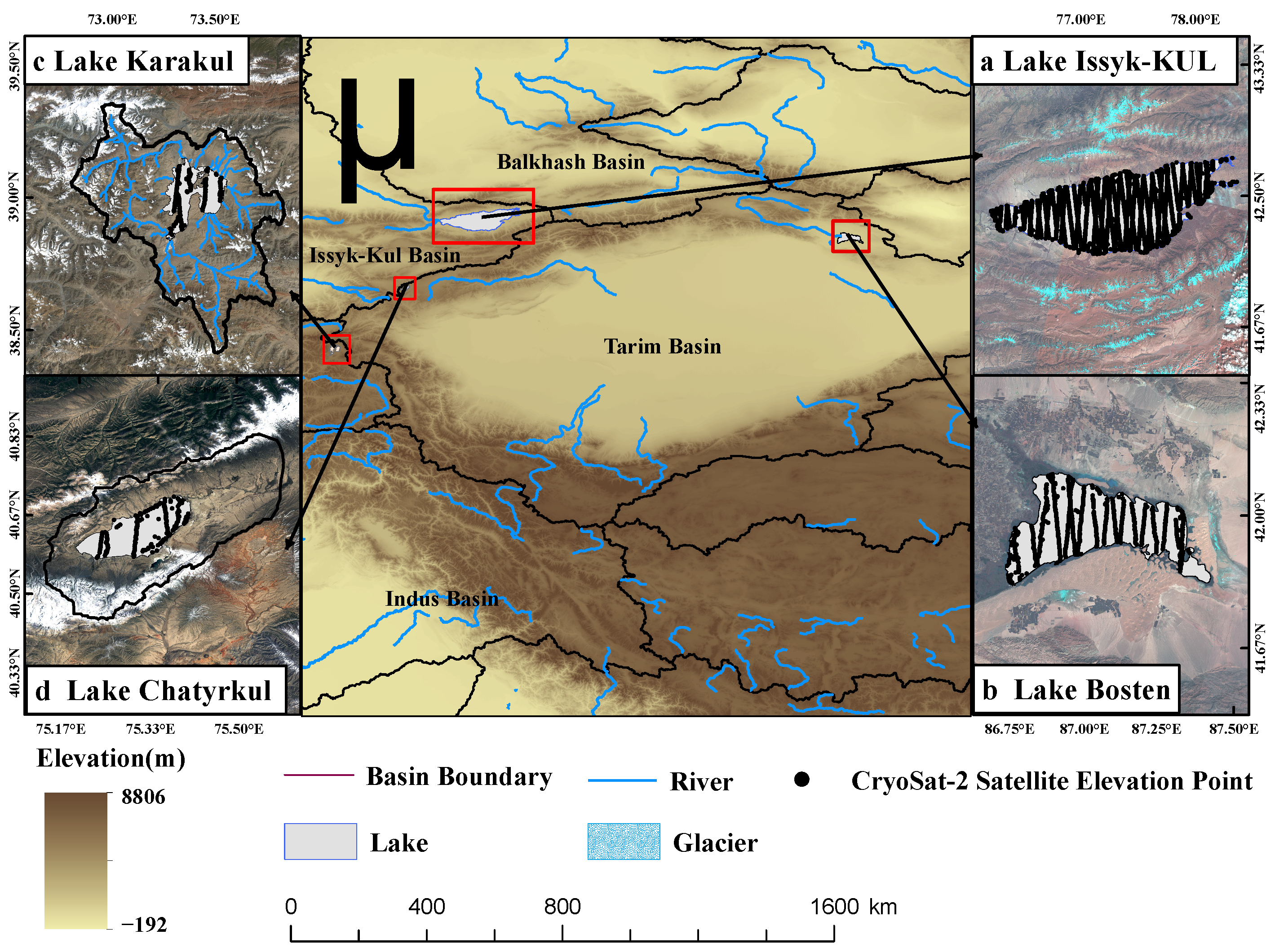

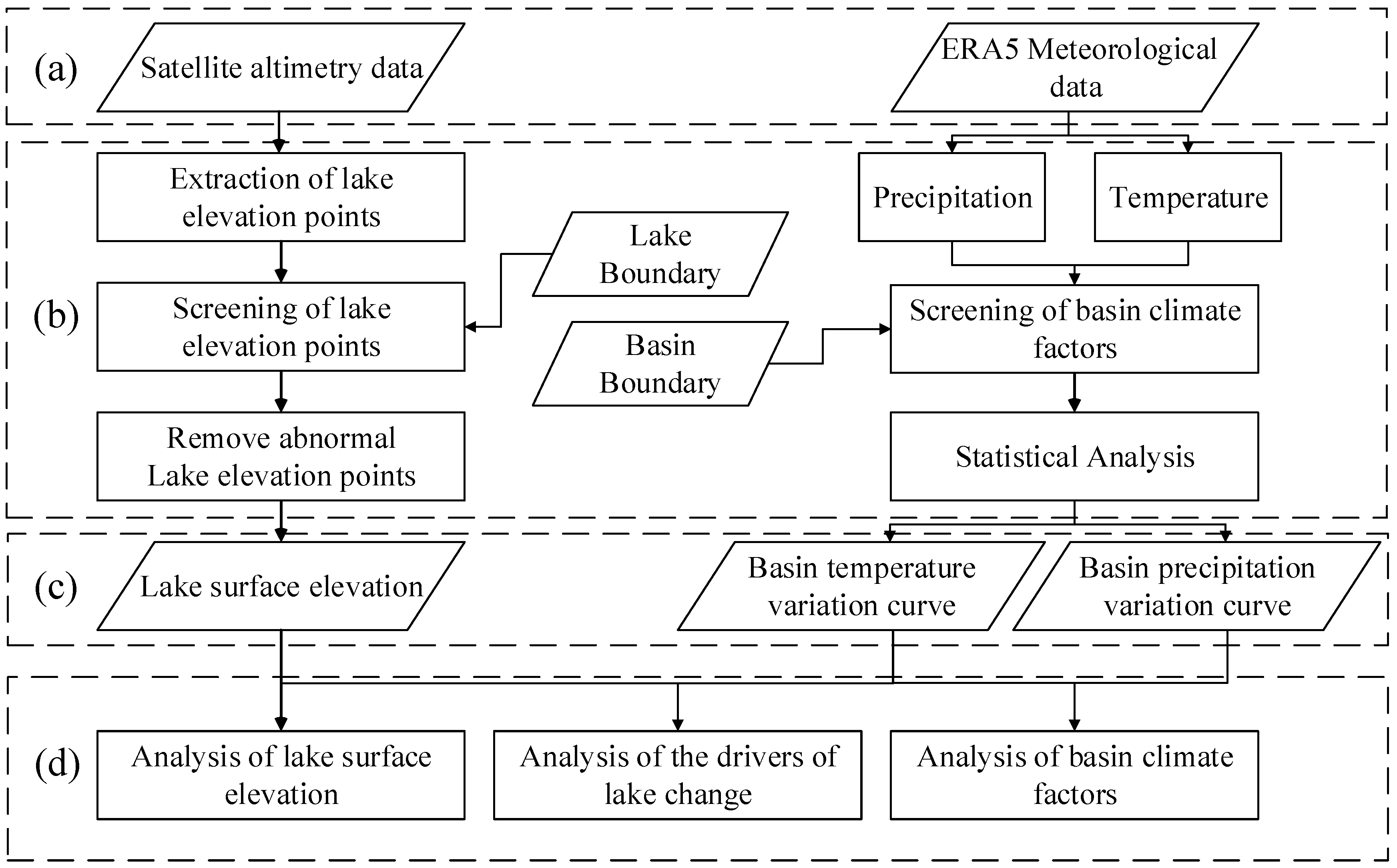

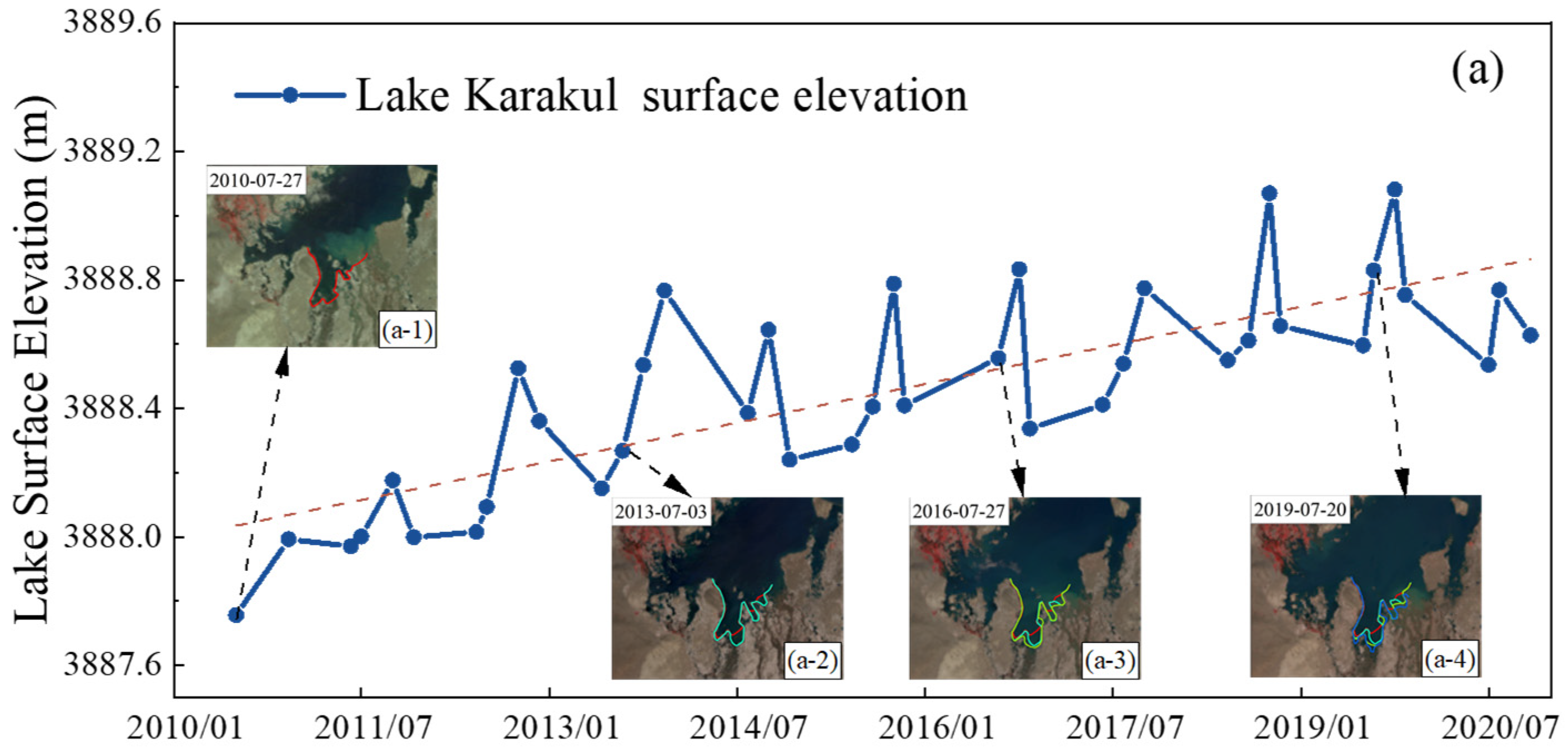
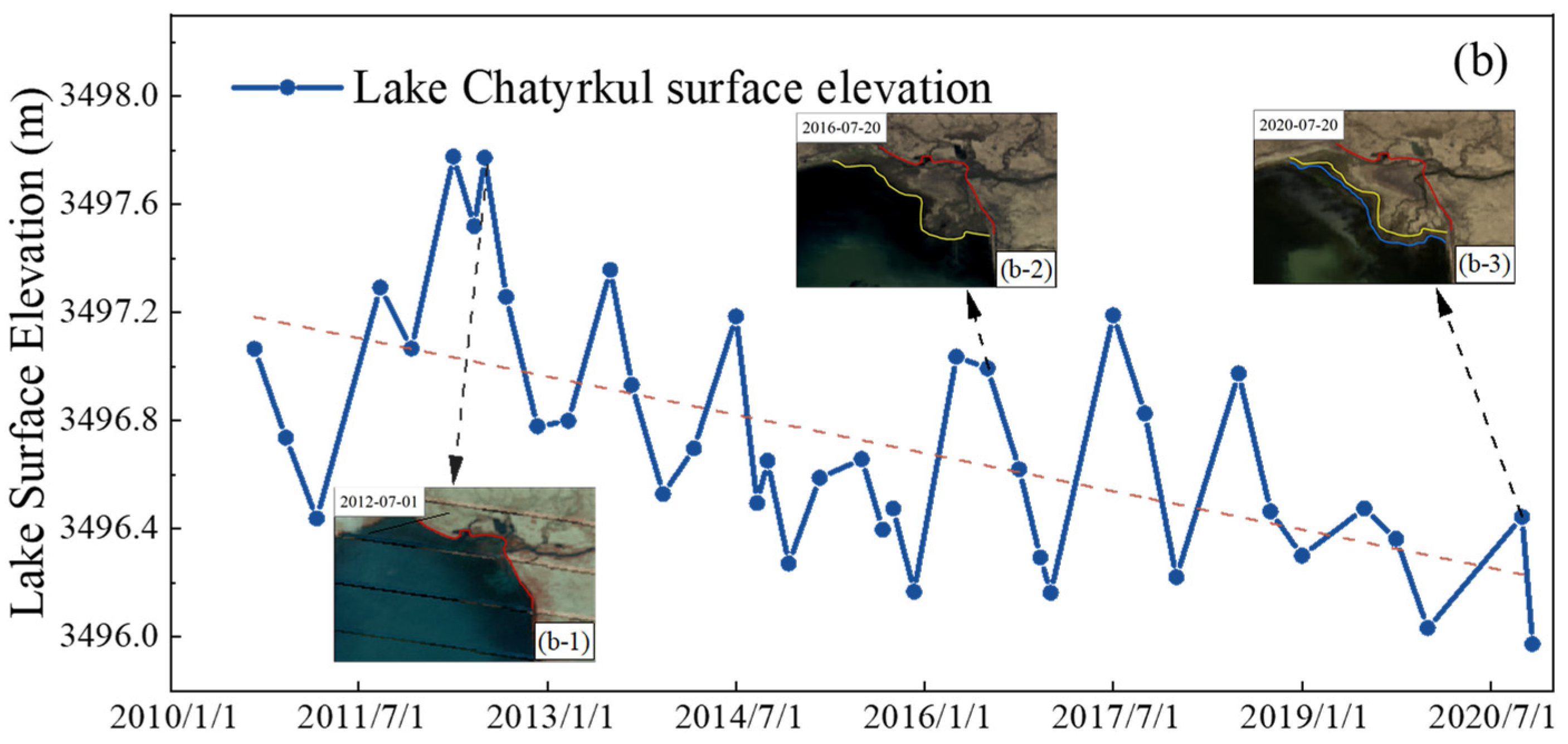
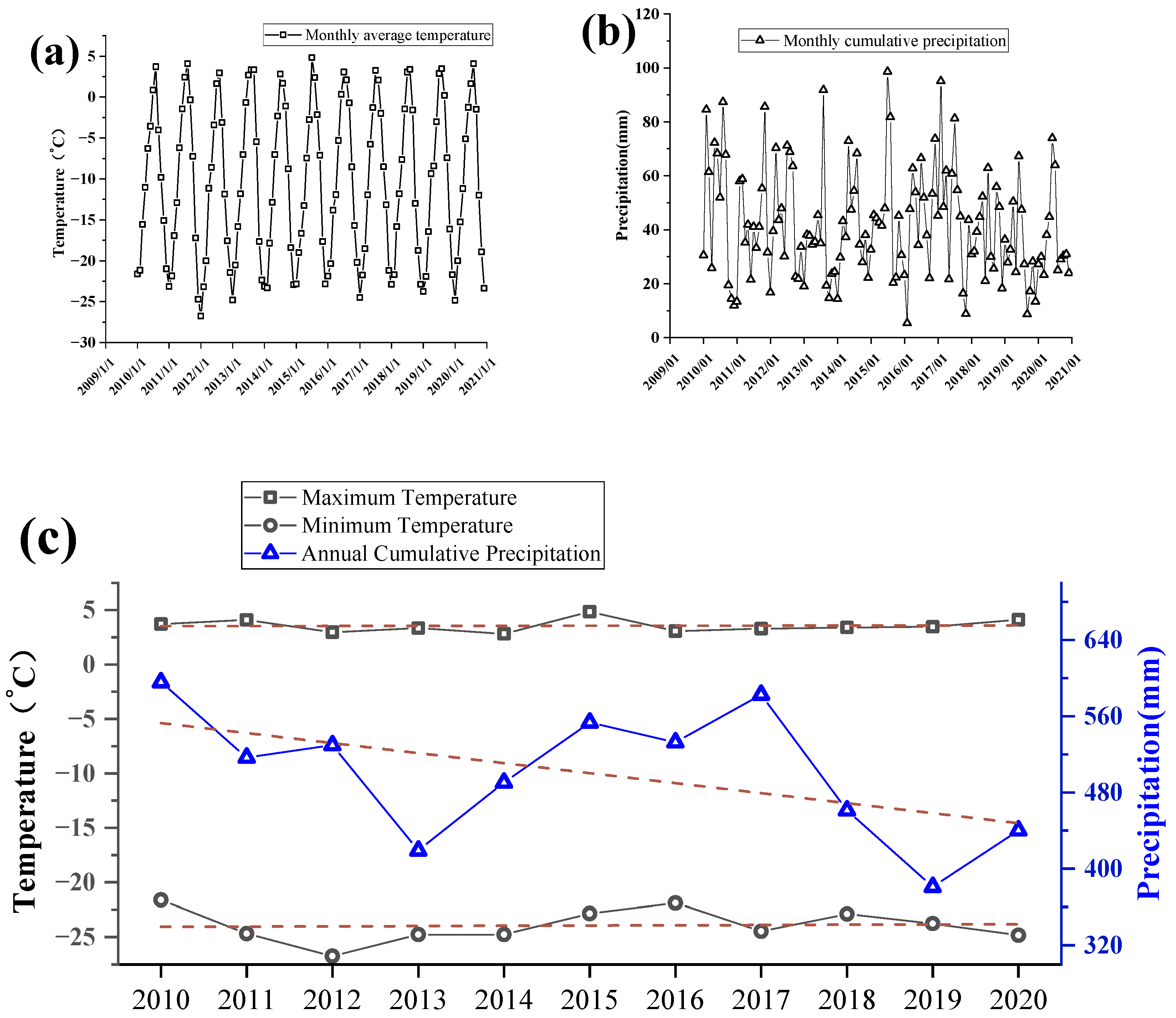
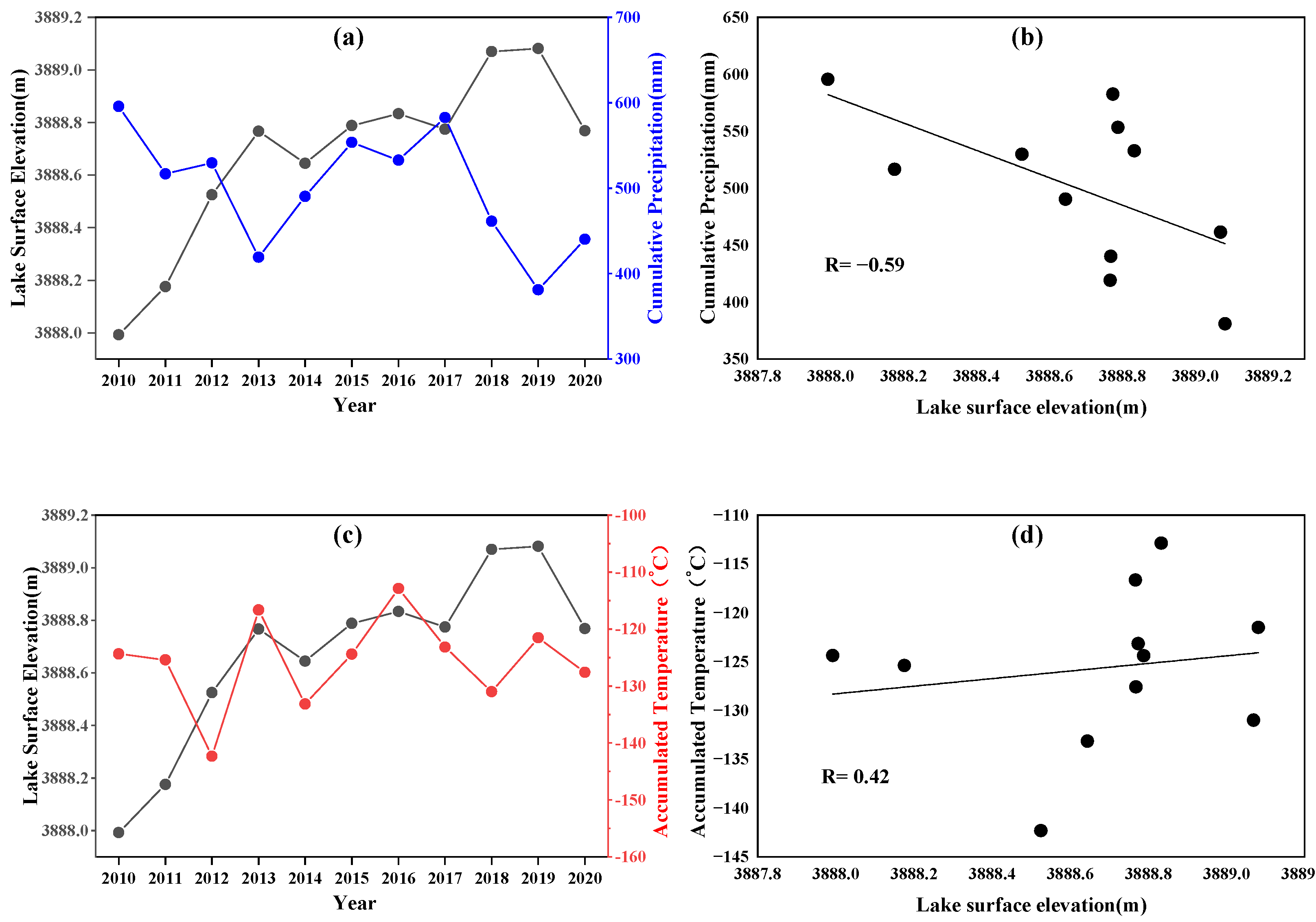
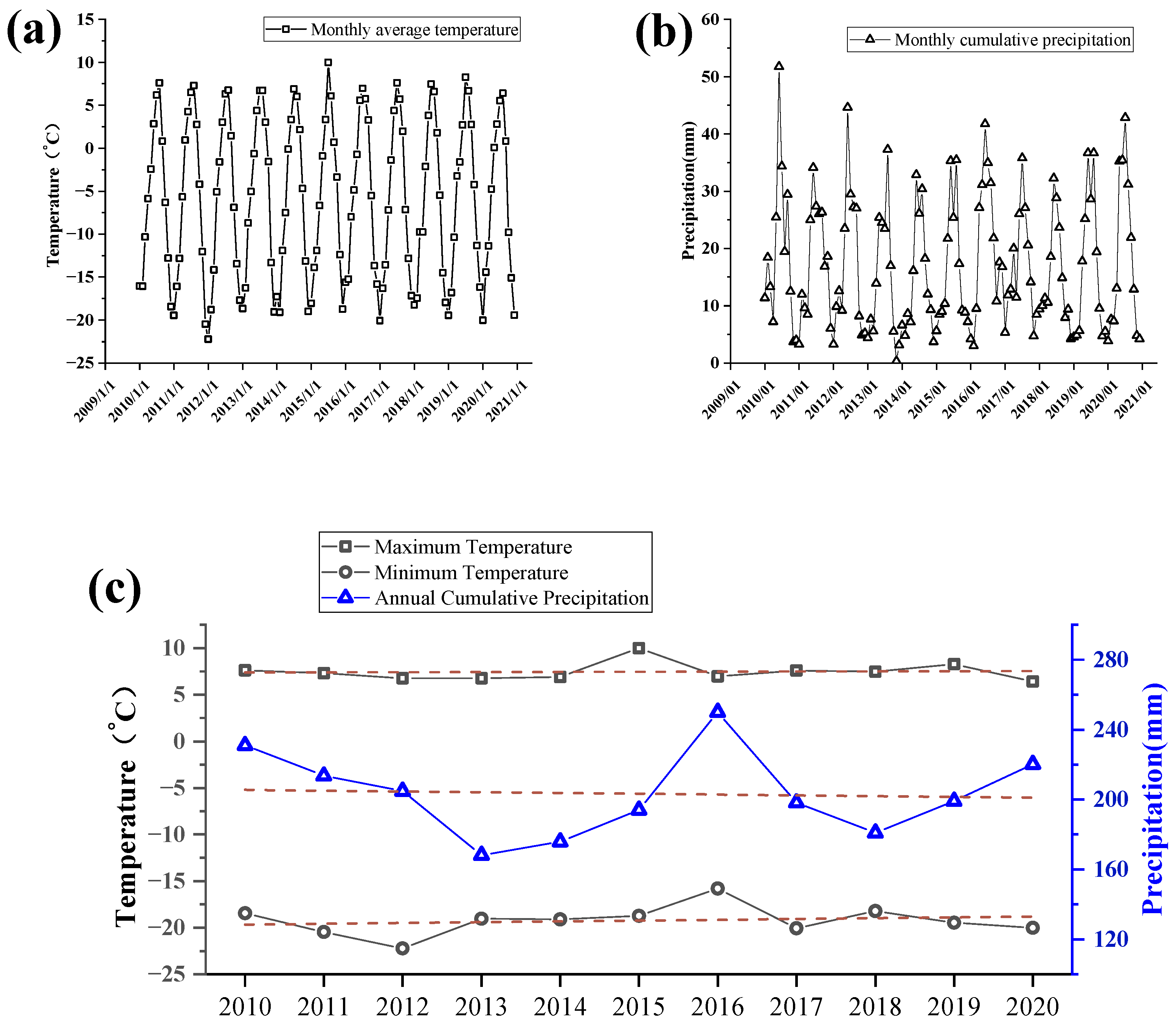
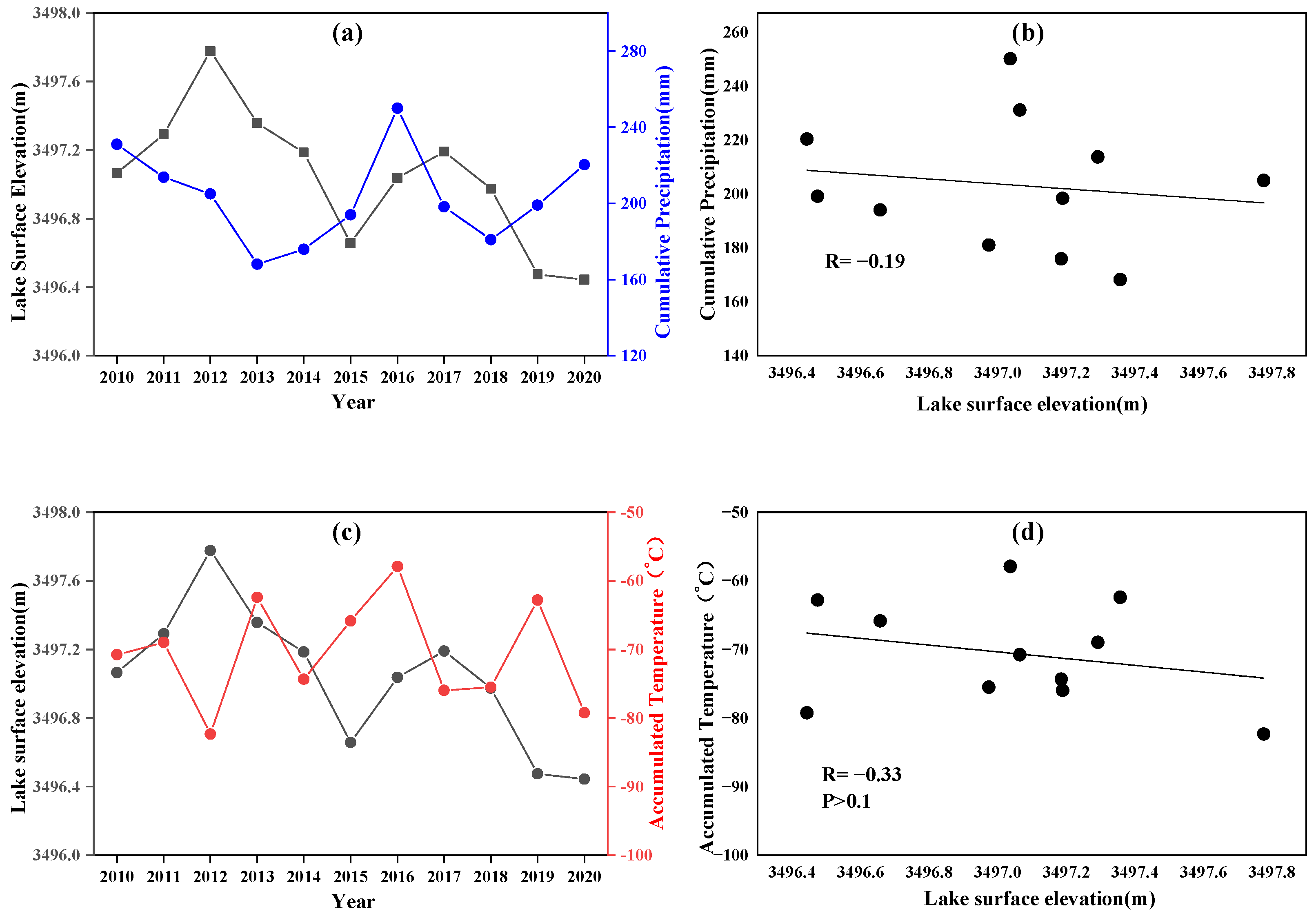
Publisher’s Note: MDPI stays neutral with regard to jurisdictional claims in published maps and institutional affiliations. |
© 2022 by the authors. Licensee MDPI, Basel, Switzerland. This article is an open access article distributed under the terms and conditions of the Creative Commons Attribution (CC BY) license (https://creativecommons.org/licenses/by/4.0/).
Share and Cite
Pan, Y.; Du, W.; Ma, D.; Lyu, X.; Cheng, C. Comparison of Typical Alpine Lake Surface Elevation Variations and Different Driving Forces by Remote Sensing Altimetry Method. Int. J. Environ. Res. Public Health 2022, 19, 17090. https://doi.org/10.3390/ijerph192417090
Pan Y, Du W, Ma D, Lyu X, Cheng C. Comparison of Typical Alpine Lake Surface Elevation Variations and Different Driving Forces by Remote Sensing Altimetry Method. International Journal of Environmental Research and Public Health. 2022; 19(24):17090. https://doi.org/10.3390/ijerph192417090
Chicago/Turabian StylePan, Yaming, Weibing Du, Dandan Ma, Xiaoxuan Lyu, and Chaoying Cheng. 2022. "Comparison of Typical Alpine Lake Surface Elevation Variations and Different Driving Forces by Remote Sensing Altimetry Method" International Journal of Environmental Research and Public Health 19, no. 24: 17090. https://doi.org/10.3390/ijerph192417090
APA StylePan, Y., Du, W., Ma, D., Lyu, X., & Cheng, C. (2022). Comparison of Typical Alpine Lake Surface Elevation Variations and Different Driving Forces by Remote Sensing Altimetry Method. International Journal of Environmental Research and Public Health, 19(24), 17090. https://doi.org/10.3390/ijerph192417090





